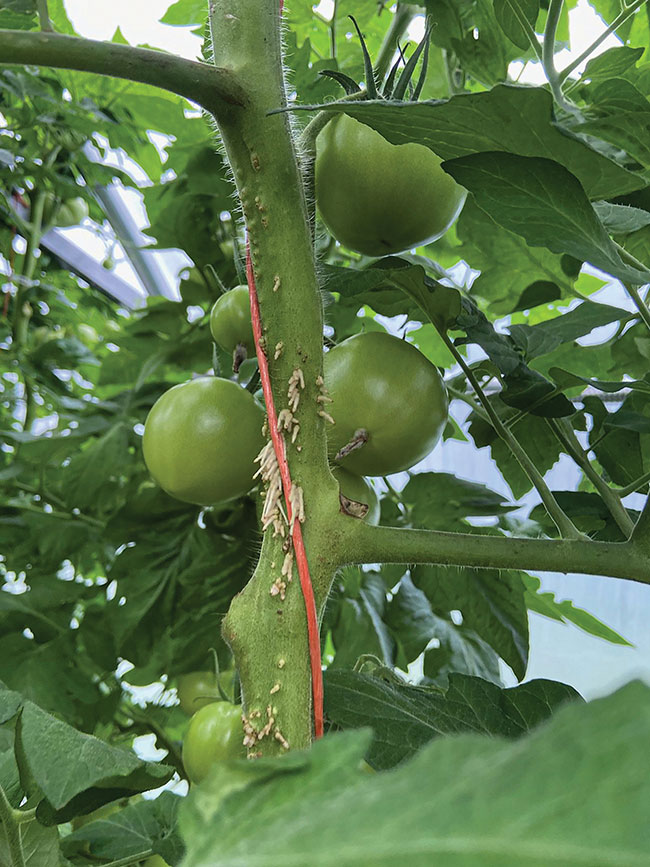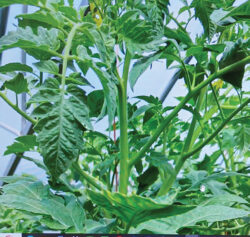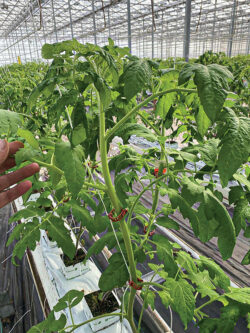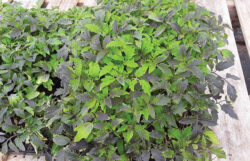
Features
Understanding tomato plant signals and making decisions for better productivity
Part 1: Plant head.
May 8, 2023 By Dr. Mohyuddin Mirza
 Roots coming out of tomato stems.
Roots coming out of tomato stems. Understanding plant signals is essential to manage crops for higher production. These are visual signals which growers can observe and interpret as to what the plant is trying to tell us if they are happy, balanced, taking up nutrients properly and giving us production consistently. For the past few years, artificial intelligence (AI) techniques are being developed and our abilities to learn what plants are trying to tell are increasing, and this is in real time. In my experience, understanding those signals is important in quick decision making before all the analytical results come in.
Tomato, indeterminate varieties grown in protected cultivation (greenhouse, glasshouse), develop three set of leaves and one cluster per week. Internode length may vary based on temperature differences between day and night and 24 hours averages.
Thus “reading” what leaves’ and flowers’ shapes, sizes, lengths and strength are is important for making decisions. A good read can guide the growers to determine the energy balance of the plant and steer plant in the right direction to achieve higher yields, and thus, better sustainability and profitability. In my opinion, with input costs going high, we must increase yields with the same inputs.
Aerial roots coming out of the stem
This happens generally near the plant head. The plant is signalling that the relative humidity is very high in the canopy and there is likely not enough air movement. Plants do give a warning before roots come out as small bumps. This may be localized in an area of the greenhouse where air flow is restricted. If condensation occurs on leaves, flowers and fruits due to dew formation, then grey mould can develop as well. Corrective actions include removing a few leaves, improving air circulation and better humidity management.
PLANT HEAD

When a plant head is too thin, fruit load is so high that the plant cannot supply enough food to the top shoots.
Thick: Too vegetative. It means the plant’s growth balance is towards producing too many leaves and less fruit. Sizing up of the fruit may also be affected. What to do?
- Increase day temperature 1 to 20C, especially during high light periods. This means adjusting the vent setting to a higher temperature.
- Increase the spread between day/night setting up to 1 to 50C. Remember, the greater the difference between the day and night temperature, the stronger the signal to the plant to become generative.
Thin: Too generative. Fruit load is so high that plant cannot supply enough food to the top shoots. Plant’s priority is to fill in the fruit as compared to producing more leaves. What to do?
- Bring day/night temperatures closer together.
- Target a head 10- to 12-mm in diameter. One inch is 25.4 mm. Measure this thickness approximately 15 cm (6 in.) from head tip or at the first fully expanded leaf before the flowering truss.
Head appears to be tight, fist-shaped and leaves are twisting.

Tight head.
Leaves do not tend to unfold until late in the day.
It is an indication of an imbalance between the vegetative and generative growth. It is more common on young crops where plants have set first two to three clusters. What to do?
- Increase the 24-hour average temperature by increasing the temperature between midnight and sunrise. Raise this temperature between 1 and 20C.
- Target a slightly higher temperature in afternoon (+1 to 20C). Curl should be out between 11 a.m. to 5 p.m.
Purple Heads
Purple tops are commonly seen in young seedlings and early crops.

Purple seedlings.
It is an indication of cooler night temperatures. Tomato plants are a very good indicator of cooler temperatures. When they are exposed to a temperature below 16C they will show a purple colour due to a deficiency of phosphorus which is not taken up. The plant will also become strongly vegetative resulting in thicker stems, shorter internodes and big flowers. Catfacing will start appearing on the fruit. Slight purpling is acceptable. What to do?
- If it is happening with the seedlings as shown in the picture, then increase day and night temperatures. Many a times growers try to hold the seedlings before planting because the greenhouse is not ready and also want to keep the plants compact. I recall a grower thought that is a disease and wanted to discard the entire crop. Once it was explained and both day and night temperatures were improved, plants recovered fully.
- If it is happening in rows along the perimeter of the greenhouse, then try to improve heat distribution and air circulation towards the side walls.
Grey Heads
This happens when plants are allowed to grow vertically very high, that is over 8 ft. Generally, it is due to high tissue temperatures combined with higher levels of carbon dioxide. It is frequently observed in April and early May when venting is limited. What to do?
- Lower your plants early.
- Reduce carbon dioxide levels to around 800 ppm.
- Introduce ammonium nitrogen around 20 ppm.
Chlorotic Heads
Young leaves show an interveinal chlorosis. Veins are distinctly green and the area in between is yellow (which may turn white). There are several reasons for this chlorosis: water-logged conditions in the root zone have resulted in a deficiency of oxygen; uptake of iron and manganese is reduced under these conditions; pH over 6.8 in soilless media may also cause head chlorosis due to deficiencies of iron and/or manganese. Very heavy fruit load is also related with this condition because of transfer of food to the root’s decreases. In summer, we have seen this problem due to warm root temperatures that are over 25C. What to do?
- Improve air in the root zone by adjusting watering practices. Avoid water-logged conditions.
- Check for sodium accumulation which can destroy the texture of the growing medium and encourage root rot.
- Make sure pH in the growing medium is between 5.8 and 6.2 by adjusting the pH of the feed solution.
- Temporarily increase iron and manganese in the feed solution by 10%.
Future issues will focus on flower trusses and flowers, leaves and fruit.
Print this page